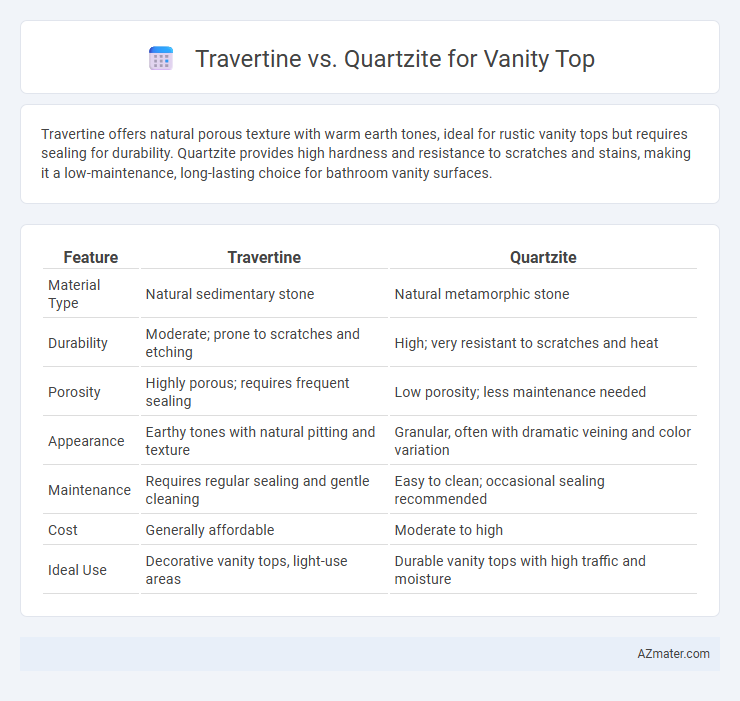Travertine offers natural porous texture with warm earth tones, ideal for rustic vanity tops but requires sealing for durability. Quartzite provides high hardness and resistance to scratches and stains, making it a low-maintenance, long-lasting choice for bathroom vanity surfaces.
Table of Comparison
| Feature | Travertine | Quartzite |
|---|---|---|
| Material Type | Natural sedimentary stone | Natural metamorphic stone |
| Durability | Moderate; prone to scratches and etching | High; very resistant to scratches and heat |
| Porosity | Highly porous; requires frequent sealing | Low porosity; less maintenance needed |
| Appearance | Earthy tones with natural pitting and texture | Granular, often with dramatic veining and color variation |
| Maintenance | Requires regular sealing and gentle cleaning | Easy to clean; occasional sealing recommended |
| Cost | Generally affordable | Moderate to high |
| Ideal Use | Decorative vanity tops, light-use areas | Durable vanity tops with high traffic and moisture |
Introduction to Travertine and Quartzite Vanity Tops
Travertine vanity tops offer a natural, porous stone with a textured surface and warm earth tones, prized for their classic Mediterranean appeal and unique veining patterns. Quartzite vanity tops provide exceptional durability and resistance to heat and scratches, featuring a harder composition and a polished, marble-like appearance with a broad spectrum of color variations. Both materials bring distinct aesthetic and functional qualities, influencing their selection for bathroom vanity surfaces.
Key Differences Between Travertine and Quartzite
Travertine is a porous sedimentary rock with natural pits and a matte finish, requiring sealing to prevent staining, while quartzite is a highly durable metamorphic rock with a dense, non-porous surface and a glossy finish. Travertine offers warm, earthy tones and a softer texture, making it more prone to scratching and etching, whereas quartzite displays a hard surface with high resistance to heat, scratches, and etching, suitable for heavy-use vanity tops. Maintenance for travertine involves regular sealing and gentle cleaning, whereas quartzite demands minimal maintenance with simple wiping, providing a longer-lasting and more resilient vanity solution.
Appearance and Color Variation
Travertine vanity tops showcase a natural, porous texture with warm earth tones ranging from creamy beige to rich caramel, offering a rustic, classic look. Quartzite provides a more durable surface with striking, dramatic veining patterns and color variations that often mimic marble, featuring shades of white, gray, and subtle blues. The distinct appearance and color variation of travertine bring warmth and character, while quartzite presents a sophisticated, high-end aesthetic ideal for modern bathroom designs.
Durability and Strength Comparison
Quartzite offers superior durability and strength compared to travertine, making it more resistant to scratches, heat, and stains for vanity tops. Travertine, a softer and more porous natural stone, requires regular sealing to prevent damage from moisture and daily use. Quartzite's high hardness rating and low porosity ensure longer-lasting performance and minimal maintenance in bathroom environments.
Maintenance Requirements
Travertine vanity tops require regular sealing to prevent stains and water damage due to their porous nature, while quartzite offers superior durability with minimal sealing needs, making it more resistant to scratches and etching. Cleaning travertine demands pH-neutral cleaners to avoid surface harm, whereas quartzite can be maintained with mild soap and water, ensuring easier daily upkeep. The low maintenance and high resilience of quartzite make it a preferred choice for busy bathrooms compared to the more delicate care required for travertine surfaces.
Stain and Scratch Resistance
Quartzite offers superior stain and scratch resistance compared to travertine, making it an ideal choice for bathroom vanity tops exposed to daily wear and moisture. While travertine's porous surface is prone to staining and scratching without proper sealing and maintenance, quartzite naturally resists these issues due to its dense structure and high silica content. Choosing quartzite ensures long-lasting durability and easier upkeep for vanity surfaces prone to water, cosmetics, and cleaning product exposure.
Cost Differences: Travertine vs Quartzite
Travertine vanity tops typically cost between $15 to $30 per square foot, making them a more budget-friendly choice compared to quartzite, which ranges from $50 to $100 per square foot. The price difference is influenced by quartzite's harder durability and resistance to heat and scratches, which justify its higher cost. Homeowners often choose travertine for its unique, porous texture and affordability, while quartzite remains preferred for long-term investment due to its strength and low maintenance.
Installation Considerations
Travertine vanity tops require careful sealing and regular maintenance to prevent staining and etching, making installation more labor-intensive compared to quartzite. Quartzite is denser and more durable, allowing for easier cutting and edge shaping with standard tools, which simplifies the installation process. Proper support and precise measurements are critical for both materials to avoid cracking or damage during installation.
Pros and Cons of Travertine Vanity Tops
Travertine vanity tops offer a natural, warm aesthetic with unique veining and a porous surface that requires regular sealing to prevent stains and water damage. The stone is softer than quartzite, making it more prone to scratches and chips but easier to repair and maintain with proper care. Despite its susceptibility to etching and discoloration from acidic substances, travertine provides a luxurious, classic look ideal for traditional or rustic bathroom designs.
Pros and Cons of Quartzite Vanity Tops
Quartzite vanity tops offer exceptional durability and resistance to scratches and heat, making them ideal for high-traffic bathroom areas. Their natural stone appearance provides a luxurious aesthetic with unique veining, but they require regular sealing to prevent staining and moisture infiltration. While quartzite is more affordable than marble, it is typically more expensive than travertine and can be harder to fabricate due to its hardness.

Infographic: Travertine vs Quartzite for Vanity Top
 azmater.com
azmater.com